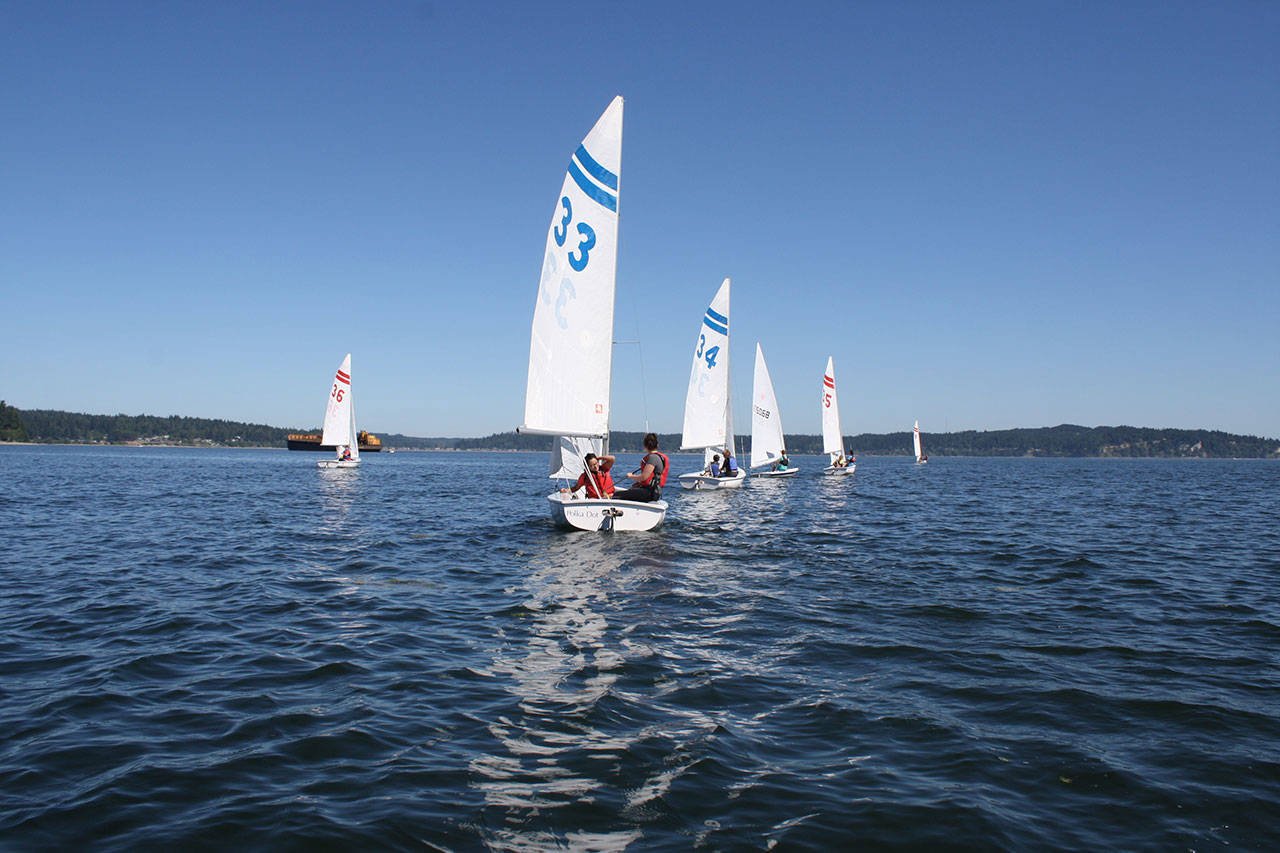The call of ripping winds and salty ocean spray is one which many ignore in favor of comfort and warmth. But those who do answer that call are often rewarded with a love of sailing early on in life. Cultivating this sentiment for the sea is the focus of the Bainbridge Island Metropolitan Park &Recreation District’s summer sailing camps.
Before they’re ready to slice through the Roaring Forties, however, students in the park district’s FJ Beginner camp need to first be taught the basics of sailing in small craft.
For the purposes of educating the camp’s 12- to 18-year-old participants, the Flying Junior (FJ) is an excellent choice, said Haley Lhamon, the park district’s sailing coordinator. Given that they are one of the most commonly used dinghies for high school and college sailing, FJ’s make a great introductory boat.
After rigging up their boats at Seattle Yacht Club’s dock in Hidden Cove — which the park district is leasing from the club — the soon-to-be salty dogs boarded their vessels and made their way toward Port Madison.
The wind leaving the cove was reliably light and the boats drifted achingly slow. The doldrums took a brief toll on the young sailors, some leaned over and stared into the water, others joked and laughed with their partners in the boats. Their boredom was short-lived, and it wasn’t long after leaving the dock that the real fun began.
Fastening a pool noodle to the transom of the lead boat, the first game of the day was about to take place. With volunteer Zach Jensen at the helm, the lead boat was set to be the rabbit in a game of chase.
“Release the hounds!” shouted sailing instructor Michael Aber from his Boston Whaler. “Sail upwind!”
Suddenly excited shouts and the rapid ratcheting of the FJ’s mainsheet blocks echoed off the water and the students tacked their boats to begin the pursuit.
After a lengthy run, one boat had closed the gap on the rabbit and appeared to be readying to nab the noodle. As the lead boat tacked back, the pursuer held his course and ran over the trailing pool noodle.
“We won!” shouted the helm of the winning boat, a young sailor named Chris Cho.
When asked what had just happened, Chris’ crew, Maddy Teran explained the rules of the game.
“We had to follow the boat with the noodle and we had to tack,” she said.
“You had to sail upwind,” Lhamon added, explaining the purpose of the drill.
When asked if they are enjoying their time on the water, Reid Nordstrom said he was having a blast, “It’s really fun!” he said before quickly turning his attention back to the action on the water.
Another sailor, Daniel Lynch, said he enjoyed the security he found in a bigger boat.
“You can’t capsize them. I can capsize an Opti,” Daniel said, referring to the smaller introductory boats called Optimists, which are used to teach younger students.
After a few more chase drills, the fleet of boats turned back toward Hidden Cove. As the FJ’s rode the wind back, the instructors ran another drill called “tacking on the whistle” where boats would tack on the command of a sharp whistle blast.
Talking about some of the challenges he finds in teaching sailing to kids, Aber said his biggest challenge was teaching downwind sailing.
“It’s hard to tell where the wind is coming from when you’re sailing downwind, because you’re obviously going with the wind,” Aber said. “They struggle with that a little bit.”
Aber noted that the repetition of drills builds the confidence of the sailors.
“Once you have them jibe enough, with a drill like jibing on the whistle, they get more comfortable in the boats,” Aber said.
“And watching out for the booms,” Lhamon added, referring to the part of the boat which holds tension on the mainsail and has a nasty habit of bonking new sailors on the head.
As the boats drifted back into Hidden Cove, they encountered the familiar lull in pressure, slowing down to a crawl.
This time, however, the mood was much more jovial. After having raced around on the water, the students were ready for more; some splashed each other while others joked, and one particularly brave young man took the opportunity to jump into the frigid, morning water.
It’s clear that regardless of whether they will continue sailing throughout their lives, answering the call of the roaring seas, these sailors are going to remember their days sailing Port Madison in the summertime for years to come.


